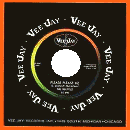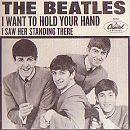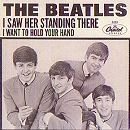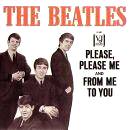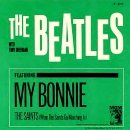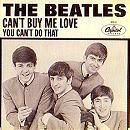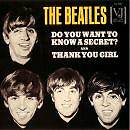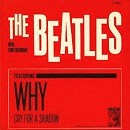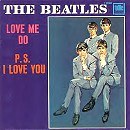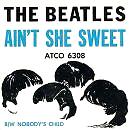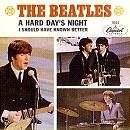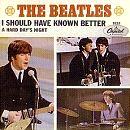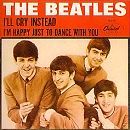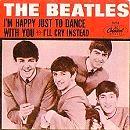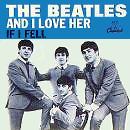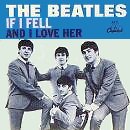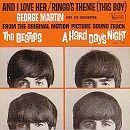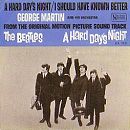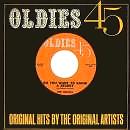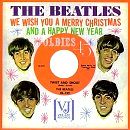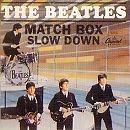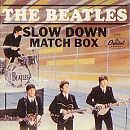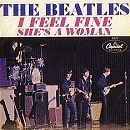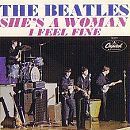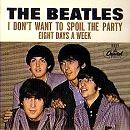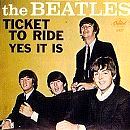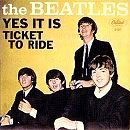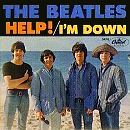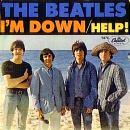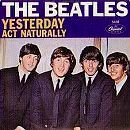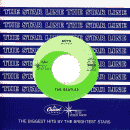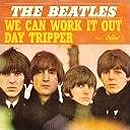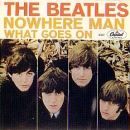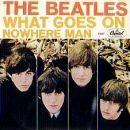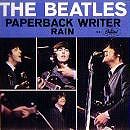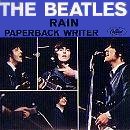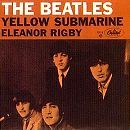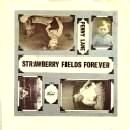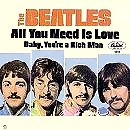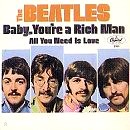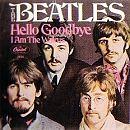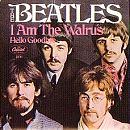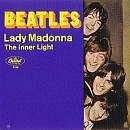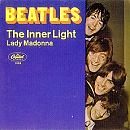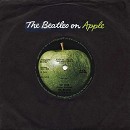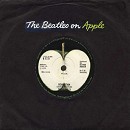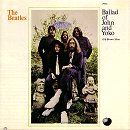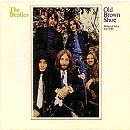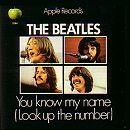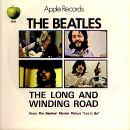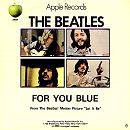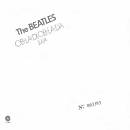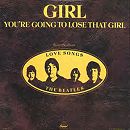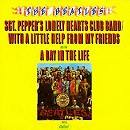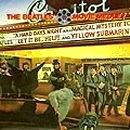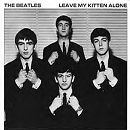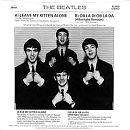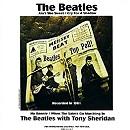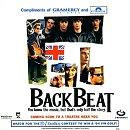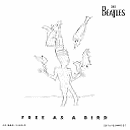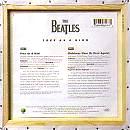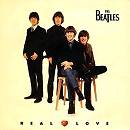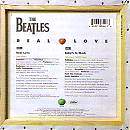 |
||||||||||||||||||||||||||||||||||||||||||||||||||||||||||||||||||||||||||||||||||||||||||
Side A: My Bonnie
|
||||||||||||||||||||||||||||||||||||||||||||||||||||||||||||||||||||||||||||||||||||||||||
|
(front cover) |
(back same as the front) |
Side A: Please Please Me
Side B: Ask Me Why
(Vee-Jay VJ 498 MONO)
Released 7th February 1963
The first official release in America was 'Please Please Me' - a copy of their second British single. Bagging the top-spot in the UK was easy enough - but impressing their label in the States was something else entirely. When Capitol turned their noses up at Mersey Beat Brian had to farm it out to Transglobal - the company that marketed the Beatles' records in the States. They originally tried to place it on the Atlantic label but Jerry Wexler turned it down. (Ironically, Atlantic would later buy up the Tony Sheridan session from Germany Polydor and release it on their subsidiary - Atco.) Transglobal eventually placed it with a small Chicago label - Vee-Jay, a poor little company with no budget. They didn't market it right and it sank without trace.
The early pressings even had a misspelling on the label, crediting the band as 'THE BEATTLES'. They eventually realised their mistake and changed the labels but, being a piss-poor company, they couldn't afford to scrap their existing stock. So some of them ended up with 'BEATTLES' on the A-side, and 'BEATLES' on the back!
All-in-all, not a very good start to their Stateside career.
Highest chart position: Billboard) didn't enter; Cashbox) didn't enter; Record World) didn't enter
US sales figures: 7,310
|
(front cover) |
(back same as the front) |
Side A: From Me To You
Side B: Thank You Girl
(Vee-Jay VJ 522 MONO)
Released 6th May 1963
Under the terms of their agreement on 10th Jan 1963, Vee-Jay had first refusal on every Beatles disc for the next five years - so Capitol weren't even offered 'From Me To You'. They'd blown it! But Vee-Jay didn't do much better... initial expectations were high when it earned Cash Box's 'Pick of the week', but a severe lack of promotion and airplay meant that it went the way of Please Please Me - absolutely nowhere.
The American singer Del Shannon jumped on board with a cover-version two months later, and seeing as he was already a big star in the States, his version got played and peaked at #77. He thus became the first person to get a Lennon/McCartney song inside the Top 100. Vee-Jay then started pushing the original with ads in the trade papers, but it was too little too late. The Beatles had suffered another dud.
Highest chart position: Billboard) #116; Cashbox) didn't
enter; Record World) didn't enter
Weeks in chart: 3 (from 3rd August 1963)
US sales figures: 21,126
|
(front cover) |
Side A: She Loves You
Side B: I'll Get You
(Swan 4152 MONO)
Released 16th September 1963
The Beatles label in the States, Vee-Jay, started having money troubles in the summer and failed to pay their royalties on time. So Transglobal (who licensed the Beatles product in the States) pulled the plug and ordered them to “cease manufacture and distribution of any and all records containing performances by The Beatles.” That left Brian in a bit of a bind, because Capitol still weren't interested in the Beatles' music. So he ordered Transglobal to find a replacement label. That label was Swan.
The deal they signed this time around was a lot tighter than the Vee-Jay disaster, and was limited to just these two songs in single format. There was no deal on first refusal, either, so Brian retained the right to offer Capitol their next single.
When it originally came out in September '63 it hardly sold any. (It wasn't helped by the lousy Cashbox press release which said: “'She Loves You' is a robust romantic rocker that the crew works over with solid sales authority. Backing's a catchy cha-cha-twist hand-clapper.”) The famous New York DJ, Murray The K (alias Murray Kaufman) remembered: “In late '63 they brought a record to me and mentioned the possibility that the Beatles might be coming to America, so I said, 'Okay,' and I put it on air. I had a record review contest on WINS at the time, where I'd play five new records each day. The audience would then vote on which records they liked best, and the winners of each week would be played next Saturday. And when I ran the Beatles in a contest with their record 'She Loves You', it came third out if five. But I still continued to play it for two or three weeks. But nothing happened. I mean, really no reaction. Absolutely nothing! Two months later I received an urgent call from my station manager in New York telling me 'The Beatles are coming!' 'Fine,' I said, 'Get an exterminator.'”
Highest chart position: Billboard) didn't enter; Cashbox) didn't enter; Record World) didn't enter
|
(front cover) |
(back cover) |
Side A: I Want To Hold Your Hand
Side B: I Saw Her Standing There
(Capitol 5122 MONO)
Released 26th December 1963
This is the single that broke the Beatles in the States. Capitol had finally cottoned onto the fact that the Beatles were going to be something special, but only after being bullied into it by Brian and EMI. He regaled the tales of Beatlemania in the UK and that was enough to convince them. But getting the band onto the label was only half the battle. Brian was mindful of the pathetic dents that other acts had made on the American charts, and insisted that Capitol spend at least $40,000 promoting the song. This was an absolutely obscene amount of money for the time (the highest that they'd ever spent on a campaign up to that point was $5,000) - even Rolf Harris could have hit number one with forty grand to spend. Backed-up by the largest ad campaign in the history of pop music, the song could hardly fail.
They originally planned on releasing it in mid-January (just before their planned appearance on The Ed Sullivan Show), but radio stations up and down the country somehow got hold of an advance copy and the demand became insatiable. They ended up bringing the release date forward seventeen days to cash in on the massive airplay.
It ended up selling a quarter of a million in the first three days, and was selling 10,000 copies an hour in New York City alone! The demand was so crazy that Capitol had to pay Columbia and RCA to help them press it up.
With this release, the Beatles became the first British act to have an American hit since the 'King Of Skiffle' Lonnie Donegan broke through in '56. (The only other British acts to have a number one were Dame Vera Lynn, Acker Bilk and the Tornadoes.) It began a record-breaking run of 17 Top 40 singles (including a three month stay at the top of the charts) and was eventually knocked off by 'She Loves You' two months later (the first time that someone had achieved two consecutive number ones since 'Love Me Tender' knocked 'Don't Be Cruel' off the top in '56). It also had the effect of opening the floodgates for every other talented act, resulting in the fabled 'British Invasion'. Because during 1964-65, British acts managed to hold onto the number one position for an entire year! Some of the groups to benefit from The Beatles' steamroller were The Rolling Stones, The Dave Clark Five, Herman's Hermits, The Animals, The Yardbirds, The Hollies and Gerry and the Pacemakers.
[Amusing note: When Capitol re-released this in 1984, they air-brushed out the cigarette.]
Highest chart position for the A-side: Billboard) #1;
Cashbox) #1; Record World) #1
It stayed top for 7 weeks (from 1st February 1964)
Weeks in chart: 15 (from 18th January 1964)
Highest chart position for the B-side:
Billboard) #14; Cashbox) #100; Record World) didn't enter
Weeks in chart: 11 (from 8th February 1964)
US sales figures: after 3 days - ¼ million; after two
weeks: 1 million; after 3 months - 3½ million; to date - over 5
million
Certified Gold on the 3rd February 1964
|
(front cover) |
(back same as the front) |
Side A: Please Please Me
Side B: From Me To You
(Vee-Jay VJ 581 MONO)
Released 3rd January 1964
After the rip-roaring success of Capitol's 'I Want To Hold Your Hand' Vee-Jay wasted no time in re-releasing all of their old stock. This time round they combined the A-sides of their first two singles, slapped on a black-and-white copy of the album sleeve, and watched it climb to number 3 - a bizarre decision, because if you look at the sales figures for the two separate singles, then you'll see that 'From Me To You' outsold 'Please Please Me' by 15,000 copies. So why did they relegate it to the flip-side?
Capitol had been quick to take Vee-Jay to court a few weeks before, and a temporary injunction slowed the sales somewhat, but it still managed to sell a million.
Highest chart position for the A-side: Billboard) #3;
Cashbox) #3; Record World) #3
Weeks in chart: 13 (from 1st February 1964)
Highest chart position for the B-side:
Billboard) #41; Cashbox) #46; Record World) didn't enter
Weeks in chart: 11 (from 14th March 1964)
US sales figures: 1,185,725
|
(front cover) |
Side A: She Loves You
Side B: I'll Get You
(Swan 4152 MONO)
Released mid-January 1964
As soon as Beatlemania started sweeping the States, every company who had a piece of the band started releasing/re-releasing all the songs they had. Swan followed up Vee-Jay's re-issue with a re-release of 'She Loves You'. And whereas last September it sunk without trace, this time it exploded - occupying the top spot for two straight weeks.
Because their deal with EMI was limited to these two songs in single format, Swan had nothing left to sell. They couldn't put them on an album because they were banned. But in a greedy piece of wheeler-dealing three months later, they decided to replace the A-side with the German language version (see below).
Highest chart position: Billboard) #1; Cashbox) #1;
Record World) #1
It stayed top for 2 weeks (from 21st March 1964)
Weeks in chart: 15 (from 25th January 1964)
US sales figures: over 2½ million
|
(front cover) |
Side A: My Bonnie
Side B: The Saints
[Both songs with Tony Sheridan]
(MGM K 13213 MONO)
Released 27th January 1964
This was a re-release from 1962. MGM snapped up the rights to the Tony Sheridan session as soon as Beatlemania started sweeping the States. This meant that they could re-issue the Decca record from 1962. Unfortunately, they decided to cheat Tony out of his credit, because instead of using 'Tony Sheridan and the Beatles' like they should do (like Decca did on the original release) MGM used the more popular 'Beatles with Tony Sheridan'.
Most of the Beatles' Hamburg cuts suffered from over-dubbing in the States because the execs wanted to make them sound 'punchier' for the American market. And this single was no exception. The session drummer, Bernard Purdie, has since claimed that “Ringo's original drum track wasn't good enough.” But as every Beatles fan will know, the drummer on the Tony Sheridan set was Pete Best!
Highest chart position: Billboard) #26; Cashbox) #29;
Record World) #31
Weeks in chart: 6 (from 15th February 1964)
|
(front cover) |
(back same as the front) |
Side A: Twist And Shout
Side B: There's A Place
(Tollie 9001 MONO)
Released 20th February 1964
After the successful re-release of 'Please Please Me', Vee-Jay wasted no time in farming out as many album tracks as possible. This one went to Tollie - their brand-new subsidiary label, which got it off to a mighty fine start, selling well over a million copies. It rose all the way to number two before getting caught behind a log-jam of Beatles' releases. Capitol's 'Can't Buy Me Love' was sitting pretty at the top, and 'She Loves You, 'I Want To Hold Your Hand' and 'Please Please Me' filled out the top 5.
Highest chart position for the A-side: Billboard) #2;
Cashbox) #1; Record World) #1
Weeks in chart: 11 (from 14th March 1964)
Highest chart position for the B-side:
Billboard) #74
Weeks in chart: 1 (from 11th April 1964)
US sales figures: 1¼ million
|
(front cover) |
(back cover) |
Side A: Can't Buy Me Love
Side B: You Can't Do That
(Capitol 5150 MONO)
Released 16th March 1964
The 'Can't Buy Me Love' single nearly didn't happen in the States, because Capitol wanted to release Roll Over Beethoven b/w Please Mr. Postman. This had already sold a bucket-load in Canada, and imported copies were sitting pretty at #68 in the Billboard chart. But George Martin suggested that they wait a little while longer for the new material. His decision proved to be a wise one, because 'Can't Buy Me Love' went on to have advance orders of 1.7 million copies - a new record!
When it knocked 'She Loves You' off the top of the tree, the Beatles had twelve songs in the Hot 100. The songs (and the positions they held) were: 1) Can't Buy Me Love; 2) Twist And Shout; 3) She Loves You; 4) I Want To Hold Your Hand; 5) Please Please Me; 31) I Saw Her Standing There; 41) From Me To You; 46) Do You Want To Know A Secret; 58) All My Loving; 65) You Can't Do That; 68) Roll Over Beethoven, and 79) Thank You Girl. And two weeks later they were joined by 74) There's A Place, and 81) Love Me Do as well. And if that wasn't enough, they also had a couple of tribute records by other bands: 42) We Love You Beatles, by The Carefrees, and 85) A Letter To The Beatles, by the Four Preps.
The Beatles went on to enjoy thirteen straight weeks at the top of the tree stretching all the back to 1st February '64 (seven for 'I Want To Hold Your Hand', two for 'She Loves You' and four for this one). It eventually came to end when Louis Armstrong knocked them off with Hello, Dolly! on 9th May.
Highest chart position for the A-side: Billboard) #1;
Cashbox) #1; Record World) #1
It stayed top for 5 weeks (from 4th April 1964)
Weeks in chart: 10 (from 28th March 1964)
Highest chart position for the B-side:
Billboard) #48; Cashbox) #77; Record World) didn't enter
Weeks in chart: 4 (from 4th April 1964)
US sales figures: after 1 day - 1 million; after 3 days
- over 2 million
Certified Gold on the 31st March 1964
|
(front cover) |
(back same as the front) |
Side A: Do You Want To Know A Secret
Side B: Thank You Girl
(Vee-Jay VJ 587 MONO)
Released 23rd March 1964
With no new product to sell, Vee-Jay continued to pull singles off their debut album. Billy J. Kramer had recently taken this to number two in England so they thought they'd have a crack. It became George's first lead vocal on a Beatles' A-side (pre-dating 'Something' by five years).
[Interesting note: The B-side to Billy J's hit was another Lennon/McCartney original - 'I'll Be On My Way'. This was never properly recorded by the Beatles - but has since been made available on Live At The BBC.]
Highest chart position for the A-side: Billboard) #2;
Cashbox) #3; Record World) #3
Weeks in chart: 11 (from 28th March 1964)
Highest chart position for the B-side:
Billboard) #35; Record World) #39
Weeks in chart: 7 (from 4th April 1964)
US sales figures: over 1 million
|
(front cover) |
Side A: Why
[With Tony Sheridan]
Side B: Cry For A Shadow
(MGM K 13227 MONO)
Released 27th March 1964
Highest chart position: Billboard) #88
Weeks in chart: 1 (from 18th April 1964)
|
(front cover) |
Side A: Love Me Do
Side B: P.S. I Love You
(Tollie 9008 MONO)
Released 27th April 1964
This was a copy of their debut British single, and did a lot better in the States - climbing all the way to number one. It was Tollie's second (and last) hit; the label folded soon after. Vee-Jay didn't have a copy of Ringo's 'Love Me Do' master tape, and had to use Andy White's instead. The version with Ringo playing drums wasn't released in America until the Rarities album came out in 1980.
You may recognise the cover painting. That's because they re-used it on the 'Jolly What!' LP.
Highest chart position for the A-side: Billboard) #1;
Cashbox) #1; Record World) #1
It stayed top for 1 week (from 30th May 1964)
Weeks in chart: 14 (from 9th May 1964)
Highest chart position for the B-side:
Billboard) #10; Cashbox) #10; Record World) #13
Weeks in chart: 3 (from 9th May 1964)
US sales figures: 1,165,200
|
(front cover) |
Side A: Sie Liebt Dich
Side B: I'll Get You
(Swan 4182 MONO)
Released 21st May 1964
Originally recorded for the German market, this German language version of 'She Loves You' was completed in fourteen takes, along with eleven takes of 'Komm, Gib Mir Deine Hand' (I Want To Hold Your Hand). But the greedy Americans decided to release it in the States as well, and the kids still went out and bought it! And they can't all have been German!
Highest chart position: Billboard) #97; Cashbox) didn't
enter; Record World) didn't enter
Weeks in chart: 1 (from 27th June 1964)
|
(front cover) |
Side A: Sweet Georgia Brown
Side B: Take Out Some Insurance On Me, Baby
[Both songs with Tony Sheridan]
(ATCO 6302 MONO)
Released 1st June 1964
This was just some songs from their Hamburg set, but the record company decided to sanitise it for the American market, taking out Tony Sheridan's swearword on 'Take Out Some Insurance On Me, Baby'. The original line went: “Take out some insurance on me, baby... Some goddammed insurance on me”, but the sanitised version went: “Take out some insurance on me, baby... Oooh, some insurance on me.” (Much better!) They also had a session drummer re-record the drum track on 'Sweet Georgia Brown', and merged it with a new guitar part.
Highest chart position: Billboard) didn't enter; Cashbox) didn't enter; Record World) didn't enter
|
(front cover) |
Side A: Ain't She Sweet
Side B: Nobody's Child
[With Tony Sheridan]
(ATCO 6308 MONO)
Released 6th July 1964
This was just a couple of cuts from the Tony Sheridan session in 1961, passed off as current material. ATCO also subjected 'Nobody's Child' to some vicious editing, cutting out the body of the second verse, and just leaving the first and last lines intact. They also shortened the ending. The result was that it ran at 2:54 instead of the usual 3:52.
You may be wondering why there are no faces on the cover. That is because Capitol owned all the rights to the Beatles image in the States and barred ATCO from using it. Luckily, the Beatles were getting so famous by this time that even their wigs were instantly recognisable!
Highest chart position: Billboard) #19; Cashbox) #14;
Record World) #13
Weeks in chart: 9 (from 18th July 1964)
|
(front cover) |
(back cover) |
Side A: A Hard Day's Night
Side B: I Should Have Known Better
(Capitol 5222 MONO)
Released 13th July 1964
The A Hard Day's Night movie was a bit of an embarrassment for Capitol because when the film contract was originally drawn up in 1963, they still couldn't give a toss about the Beatles' product. Vee-Jay had just seen their first two singles flop out of sight, and the idea of wasting a load of money on some shit-arse British band made the Capitol big-wigs laugh out loud. So EMI signed the rights over to the film's distributors - United Artists. By the time the movie came out in '64, however, the picture had changed dramatically. The Beatles were now the hottest property in showbiz, and United Artists had the rights to the soundtrack!
Fortunately, Capitol still had a get-out-of-jail-free card because UA could only market the songs as a soundtrack; and seeing as Capitol had sole distribution rights in the US, there was nothing to stop them releasing the songs in other formats (i.e. single and album tracks) - hence the head-butting battle between two of the biggest labels in the States.
Capitol's plan was two-fold, 1) they would release six of the seven soundtrack songs on singles, and 2) they would include all of the movie songs on their forthcoming Something New LP. The first of these to go out was A Hard Day's Night b/w I Should Have Known Better (which differed from the British release, because they had 'Things We Said Today' on the back).
It stayed top for two weeks, until it was overtaken by Dean Martin's 'Everybody Loves Somebody', and The Supremes 'Where Did Our Love Go'. They also made a little bit of history by becoming the first band to hold onto the top spot in both the album and the singles chart, in both the UK and the States. Simon and Garfunkel were the next group to do it, with Bridge Over Troubled Water in 1970.
The sleeve had pictures of The Beatles record-breaking appearance on The Ed Sullivan Show in February '64, and the Ringo shot was from their gig at the Washington Coliseum.
Highest chart position for the A-side: Billboard) #1;
Cashbox) #1; Record World) #1
It stayed top for 2 weeks (from 1st August 1964)
Weeks in chart: 13 (from 18th July 1964)
Highest chart position for the B-side:
Billboard) #53; Cashbox) #43; Record World) didn't enter
Weeks in chart: 4 (from 25th July 1964)
US sales figures: after 5 weeks - over 1 million
Certified Gold on the 25th August 1964
|
(front cover) |
(back cover) |
Side A: I'll Cry Instead
Side B: I'm Happy Just To Dance With You
(Capitol 5234 MONO)
Released 20th July 1964
One week after 'A Hard Day's Night' hit the shops, Capitol followed up with another two singles of soundtrack songs. The first one was I'll Cry Instead b/w I'm Happy Just To Dance With You. Dick Lester kind of ruined their promotion, though, by cutting 'I'll Cry Instead' from the movie at the last minute - preferring a repeat of 'Can't Buy Me Love'.
Highest chart position for the A-side: Billboard) #25;
Cashbox) #22; Record World) #28
Weeks in chart: 7 (from 1st August 1964)
Highest chart position for the B-side:
Billboard) #95; Cashbox) didn't enter; Record World) #103
Weeks in chart: 1 (from 1st August 1964)
|
(front cover) |
(back cover) |
Side A: And I Love Her
Side B: If I Fell
(Capitol 5235 MONO)
Released 20th July 1964
The last soundtrack single was And I Love Her b/w If I Fell. (The only song from the movie not to appear on a single was 'Tell Me Why'.) The cover shows the same Dezo Hoffmann shot that appears on the Four By The Beatles EP.
Highest chart position for the A-side: Billboard) #12;
Cashbox) #14; Record World) #16
Weeks in chart: 9 (from 25th July 1964)
Highest chart position for the B-side:
Billboard) #53; Cashbox) #64; Record World) #59
Weeks in chart: 9 (from 1st August 1964)
|
And I Love Her |
A Hard Day's Night |
United Artists gets in on the act...
Whilst Capitol were well within their rights releasing A Hard Day's Night as a single, only United Artists could release a soundtrack to the movie. Both companies were quick to try and out-do the other... Capitol immediately issued six of the soundtrack songs on singles, and UA copied two of their 45s: And I Love Her b/w Ringo's Theme (This Boy), and A Hard Day's Night b/w I Should Have Known Better.
Unfortunately, because Capitol had beaten them into the
shops (And I Love Her came out in August, and A Hard Day's
Night came out in October), and were already available on the
LP, both singles failed to make the Top 50. And the fact that they
were all instrumentals by the George Martin Orchestra didn't exactly
help much either!
|
The Oldies sleeve |
The Christmas sleeve |
Vee-Jay's last throw of the dice...
During the summer of '64, Vee-Jay started up yet another subsidiary label, and this time called it 'Oldies'. Their license to release Beatles singles was due to expire in October, so they quickly re-released all of their 45s in another cover to make a bit more money. Capitol weren't exactly over-the-moon about it, but repeated the feat themselves a year later.
The singles and their B-sides were: Do You Want To Know A Secret b/w Thank You Girl; Please Please Me b/w From Me To You; Love Me Do b/w P.S. I Love You, and Twist And Shout b/w There's A Place.
They also issued a special Christmas sleeve in early
October to gain a slice of the Xmas market. Once again, this was not
a new release, but merely a slip to replace the existing cover of a
single proving hard to shift. Most of these sleeves ended up on the
Oldies discs.
|
(front cover) |
(back cover) |
Side A: Matchbox
Side B: Slow Down
(Capitol 5255 MONO)
Released 24th August 1964
With no new product to sell, Capitol decided to pull something old off the Something New LP. Ringo was far-and-away the most popular Beatle in the States, so he was treated to his first-ever A-side (and he got one more A and a couple of B's as well before the end of the decade. Imagine how George must have felt!).
Highest chart position for the A-side: Billboard) #17;
Cashbox) #17; Record World) #22
Weeks in chart: 8 (from 5th September 1964)
Highest chart position for the B-side:
Billboard) #25; Cashbox) #34; Record World) #23
Weeks in chart: 7 (from 5th September 1964)
|
(front cover) |
(back cover) |
Side A: I Feel Fine
Side B: She's A Woman
(Capitol 5327 MONO)
Released 23rd November 1964
This sold a million copies in the first week. The cover shows a gig at the Las Vegas Convention Center, in August '64.
Highest chart position for the A-side: Billboard) #1;
Cashbox) #1; Record World) #1
It stayed top for 3 weeks (from 26th December 1964)
Weeks in chart: 11 (from 5th December 1964)
Highest chart position for the B-side:
Billboard) #4; Cashbox) #8; Record World) #7
Weeks in chart: 9 (from 5th December 1964)
US sales figures: after 1 week - over 1 million
Certified Gold on the 31st December 1964
|
(front cover) |
(back cover) |
Side A: Eight Days A Week
Side B: I Don't Want To Spoil The Party
(Capitol 5371 MONO)
Released 15th February 1965
When Capitol compiled Beatles '65, they only used eight of the fourteen songs on offer from Beatles For Sale. They held the rest back for Beatles VI and this single. It knocked The Temptations' 'My Girl' off the top, and was dethroned by The Supremes' 'Stop! In The Name Of Love' two weeks later.
Highest chart position for the A-side: Billboard) #1;
Cashbox) #1; Record World) #1
It stayed top for 2 weeks (from 13th March 1965)
Weeks in chart: 10 (from 20th February 1965)
Highest chart position for the B-side:
Billboard) #39; Cashbox) #83; Record World) didn't enter
Weeks in chart: 6 (from 20th February 1965)
US sales figures: over 1 million
Certified Gold on the 16th September 1965
|
(front cover) |
(back cover) |
Side A: Ticket To Ride
Side B: Yes It Is
(Capitol 5407 MONO)
Released 19th April 1965
The original label for this single carried the line: 'From the United Artists release Eight Arms To Hold You'. (They changed the name to Help! soon after.) It was knocked off the top by the Beach Boys' 'Help Me Rhonda'.
Highest chart position for A-side: Billboard) #1;
Cashbox) #1; Record World) #1
It stayed top for 1 week (from 22nd May 1965)
Weeks in chart: 11 (from 24th April 1965)
Highest chart position for B-side: Billboard)
#46; Cashbox) didn't enter; Record World) didn't enter
Weeks in chart: 4 (from 1st May 1965)
|
(front cover) |
(back cover) |
Side A: Help!
Side B: I'm Down
(Capitol 5476 MONO)
Released 19th July 1965
This came out two weeks before the movie, and took a month to reach the top spot. It had trouble getting past Sonny and Cher's 'I Got You Babe' and the Beach Boys' 'California Girls'. When it finally reached the summit it had to do battle with Bob Dylan's 'Like A Rolling Stone' and Barry McGuire's 'Eve Of Destruction'.
The cover photo was taken by Robert Freeman on a Bahamas' beach, during the filming of the movie.
Highest chart position for A-side: Billboard) #1;
Cashbox) #1; Record World) #1
It stayed top for 3 weeks (from 4th September 1965)
Weeks in chart: 13 (from 7th August 1965)
Highest chart position for B-side: Billboard)
#101; Cashbox) didn't enter; Record World) didn't enter
Weeks in chart: 7 (from 7th August 1965)
US sales figures: after 2 months - over 1 million
Certified Gold on the 2nd September 1965
|
(front cover) |
(back cover) |
Side A: Yesterday
Side B: Act Naturally
(Capitol 5498 MONO)
Released 13th September 1965
This was released one day after performing it on The Ed Sullivan Show. Capitol had held it back from the Help! soundtrack, because, unlike the British LP, they replaced the non-soundtrack songs with instrumentals. It was eventually knocked off the top by the Stones' classic 'Get Off Of My Cloud'.
'Yesterday' was the most-played song on American radio for eight years running.
Highest chart position for the A-side: Billboard) #1;
Cashbox) #1; Record World) #1
It stayed top for 4 weeks (from 9th October 1965)
Weeks in chart: 11 (from 25th September 1965)
Highest chart position for the B-side:
Billboard) #47; Cashbox) #28; Record World) #21
Weeks in chart: 7 (from 25th September 1965)
US sales figures: after 5 weeks - over 1 million
Certified Gold on the 20th October 1965
|
front cover |
Some brand new 'Golden Oldies'...
On the 11th October 1965, Capitol re-released the four Vee-Jay singles on it's budget/Oldies label, Capitol Starline. This was the second time in under a year that they had been marketed this way. The songs and their B-sides were: Do You Want To Know A Secret b/w Thank You Girl; Please Please Me b/w From Me To You; Love Me Do b/w P.S. I Love You, and Twist And Shout b/w There's A Place.
They also released a couple of Canadian imports:
Roll Over Beethoven b/w Misery, and Boys b/w
Kansas City/Hey-Hey-Hey-Hey! The only one out of the six to
chart was Boys, reaching #102 on Billboard.
|
(front cover) |
(back same as the front) |
We Can Work It Out
Day Tripper
(Capitol 5555 MONO)
Released 6th December 1965
DOUBLE A-SIDE
Marketed as a double A-side, Paul's 'We Can Work It Out' just edged out John's 'Day Tripper' from the top of the tree, spending a combined total of three weeks at No.1. It swapped places with Simon and Garfunkel's 'Sound Of Silence' for a while, before finally succumbing to Petula Clark's 'My Love' and the Beach Boys' 'Barbara Ann'.
The photo was nicked from the cover of Beatles For Sale and Beatles '65.
Highest chart position for 'We Can Work It Out':
Billboard) #1; Cashbox) #1; Record World) #1
It stayed top for a combined total of 3 weeks (two weeks from 1st
January, and one week from 29th January 1966)
Weeks in chart: 12 (from 18th December 1965)
Highest chart position for 'Day Tripper': Billboard) #5; Cashbox) #10;
Record World) #13
Weeks in chart: 10 (from 28th December 1965)
US sales figures: after 1 month - over 1 million
Certified Gold on the 6th January 1966
|
(front cover) |
(back cover) |
Side A: Nowhere Man
Side B: What Goes On
(Capitol 5587 MONO)
Released 15th February 1966
This was kept off the top spot by Sgt. Barry Sandler's 'The Ballad Of The Green Berets' and the Rolling Stones' '19th Nervous Breakdown'.
The photo was nicked from the back of Beatles For Sale, and was re-used on Capitol's The Early Beatles LP. The early pressings credit 'What Goes On' to 'John Lennon - Paul McCartney', but should have read 'Lennon-McCartney-Starr'. (Ringo waited four years to get a composer credit, and then got scrubbed off the label!) Later pressings corrected the mistake, but because there are relatively few of the correct ones around, they are actually worth more than the originals!
Highest chart position for the A-side: Billboard) #3;
Cashbox) #2; Record World #1
Weeks in chart: 9 (from 5th March 1966)
Highest chart position for the B-side:
Billboard) #81; Cashbox) didn't enter; Record World) #99
Weeks in chart: 2 (from 12th March 1966)
US sales figures: after 8 days - ¾ million; after 5
weeks - over 1 million
Certified Gold on the 1st April 1966
|
(front cover) |
(back cover) |
Side A: Paperback Writer
Side B: Rain
(Capitol 5651 MONO)
Released 30th May 1966
This beat off competition from Frank Sinatra's 'Strangers In The Night', and the Rolling Stones' 'Paint It Black', before succumbing to The Troggs' classic 'Wild Thing'.
The cover photo is a bit bizarre, because it flips the pictures of John and George, so it looks like they're strumming their guitars with the wrong hand.
Highest chart position for the A-side: Billboard) #1;
Cashbox) #1; Record World) #1
It stayed top for a combined total of 2 weeks (one week from 25th
June, and one week 8th July 1966)
Weeks in chart: 10 (from 11th June 1966)
Highest chart position for the B-side:
Billboard) #23; Cashbox) #31; Record World) #28
Weeks in chart: 7 (from 11th June 1966)
US sales figures: after 1 week - ¾ million; after 5
weeks - over 1 million
Certified Gold on the 14th July 1966
|
(front cover) |
(back same as the front) |
Side A: Yellow Submarine
Side B: Eleanor Rigby
(Capitol 5715 MONO)
Released 8th August 1966
Whereas this was marketed as a double A-side in Britain, Capitol chose to throw it's weight behind 'Yellow Submarine'. It was kept off the top spot by The Supremes' 'You Can't Hurry Love'. It's poor showing (it only reached number two) was caused in part by their record ban in the Southern states - John had just caused a furore with his 'Jesus' comment.
The cover photo was taken at their 13th August press conference in New York. It was also the groups 21st gold record, beating the record set by Elvis.
Highest chart position for the A-side: Billboard) #2;
Cashbox) #1; Record World) #1
Weeks in chart: 9 (from 20th August 1966)
Highest chart position for B-side: Billboard)
#11; Cashbox) #12; Record World) #16
Weeks in chart: 8 (from 27th August 1966)
US sales figures: after 4 weeks - 1,200,000
Certified Gold on the 12th September 1966
|
(front cover) |
(back cover) |
Strawberry Fields Forever
Penny Lane
(Capitol 5810 MONO)
Released 13th February 1967
DOUBLE A-SIDE
By February '67 Capitol were getting desperate for another single - having gone through the entire Christmas period without any new music. (In Britain, EMI had decided to release a 'Greatest Hits' package to plug the gap, but for some reason Capitol abstained). They asked Brian to pull some songs from the Pepper sessions and Martin came up with this. “Knowing how desperate Brian was feeling, I decided to give him a super strong combination,” said George, “a double-punch that could not fail, and unbeatable linking of two all-time great songs: Strawberry Fields Forever and Penny Lane. These songs would, I told him, make a fantastic double A-sided disc.” Unfortunately, Martin's plan backfired somewhat when it was kept off the top spot in the UK by Engelbert Humperdinck! In America, however, it was a different story, and 'Penny Lane' beat off competition from the Rolling Stone's 'Ruby Tuesday'.
Highest chart position for 'Strawberry Fields Forever':
Billboard) #8; Cashbox) #10; Record World) #9
Weeks in chart: 9 (from 25th February 1967)
Highest chart position for 'Penny Lane': Billboard) #1; Cashbox) #1;
Record World) #1
It stayed top for 1 week (from 18th March 1967)
Weeks in chart: 10 (from 25th February 1967)
US sales figures: after 5 weeks - over 1 million
Certified Gold on the 20th March 1967
|
(front cover) |
(back cover) |
Side A: All You Need Is Love
Side B: Baby, You're A Rich Man
(Capitol 5964 MONO)
Released 17th July 1967
This knocked the Doors' 'Light My Fire' off the top, reaching number one on the same day that Ringo's missus gave birth to baby Jason.
Highest chart position for the A-side: Billboard) #1;
Cashbox) #1; Record World) #1
It stayed top for 1 week (from 19th August 1967)
Weeks in chart: 11 (from 22nd July 1967)
Highest chart position for the B-side:
Billboard) #34; Cashbox) #60; Record World) #60
Weeks in chart: 5 (from 29th July 1967)
US sales figures: over 1 million
Certified Gold on the 11th September 1967
|
(front cover) |
(back cover) |
Side A: Hello, Goodbye
Side B: I Am The Walrus
(Capitol 2056 MONO)
Released 27th November 1967
This knocked the Monkees' 'Daydream Believer' off the top, before succumbing to John Fred's parody of 'Lucy In The Sky With Diamonds', called 'Judy In Disguise (With Glasses)'.
Highest chart position for the A-side: Billboard) #1;
Cashbox) #1; Record World) #1
It stayed top for 3 weeks (from 30th December 1967)
Weeks in chart: 11 (from 2nd December 1967)
Highest chart position for the B-side:
Billboard) #56; Cashbox) #46; Record World) #46
Weeks in chart: 4 (from 9th December 1967)
US sales figures: after 3 weeks - over 1 million
Certified Gold on the 15th December 1967
|
(front cover) |
(back cover) |
Side A: Lady Madonna
Side B: The Inner Light
(Capitol 2138 MONO)
Released 18th March 1968
Even though this failed to reach number one, it still sold well over a million copies in it's first week.
Highest chart position for the A-side: Billboard) #4;
Cashbox) #2; Record World) #2
Weeks in chart: 11 (from 23rd March 1968)
Highest chart position for the B-side:
Billboard) #97; Cashbox) didn't enter; Record World) didn't enter
Weeks in chart: 1 (from 30th March 1968)
US sales figures: after 1 week - over 1 million
Certified Gold on the 8th April 1968. Certified Platinum on the 17th
February 1999
|
(front cover) |
(back cover) |
Side A: Hey Jude
Side B: Revolution
(Apple 2276 MONO)
Released 26th August 1968
'Hey Jude' was the Beatles first single to be released on their new Apple label, and stayed on top for nine weeks (which set a new American record). It also became the longest-ever song to make it to number one (at 7:11). But US radio was adverse to playing anything over three minutes, and Capitol had to press up a special edit for radio play.
It also kept Apple's second single - Mary Hopkins' Those Were The Days stuck at number two, before finally succumbing to Diana Ross and the Supremes.
Highest chart position for the A-side: Billboard) #1;
Cashbox) #1; Record World) #1
It stayed top for 9 weeks (from 28th September 1968)
Weeks in chart: 19 (from 14th September 1968)
Highest chart position for the B-side:
Billboard) #12; Cashbox) #11; Record World) #2
Weeks in chart: 11 (from 14th September 1968)
US sales figures: after 2 months - just under 3 million;
after 5 months - 3¾ million; to date - between 4 and 5 million
Certified Gold on the 13th September 1968. Certified Platinum on the
17th February 1999
|
(front cover) |
(back cover) |
Side A: Get Back
Side B: Don't Let Me Down
(Apple 2490 STEREO)
Released 5th May 1969
The Beatles first stereo single. It stayed on top for five weeks, before being overtaken by Henry Mancini's 'Love theme From Romeo And Juliet' and the Creedance Clearwater Revival classic 'Bad Moon Rising'.
Highest chart position for the A-side: Billboard) #1;
Cashbox) #1; Record World) #1
It stayed top for 5 weeks (from 24th May 1969)
Weeks in chart: 12 (from 10th May 1969)
Highest chart position for the B-side:
Billboard) #35
Weeks in chart: 4 (from 10th May 1969)
US sales figures: over 2 million
Certified Gold on the 19th May 1969. Certified Platinum on the 17th
February 1999
|
(front cover) |
(back cover) |
Side A: The Ballad Of John And Yoko
Side B: Old Brown Shoe
(Apple 2531 STEREO)
Released 4th June 1969
This was released less than a month after 'Get Back' came out, and part of the reason it did so badly (it only reached number eight) was because 'Get Back' was still riding high at number one. There was also the predictable outcry over the usage of the word “Christ” in the chorus, coming so soon as it did after John's 'Jesus' comment. Apple came under considerable pressure to bleep it out, but steadfastly refused. Various radio stations up and down the country then banned it, or resorted to playing the B-side instead, denting sales.
Highest chart position: Billboard) #8; Cashbox) #10;
Record World) #7
Weeks in chart: 9 (from 14th June 1969)
Highest chart position for the B-side: Billboard) did not chart; Cashbox) did not chart; Record World) did not chart
US sales figures: over 1 million
Certified Gold on the 16th June 1969
|
(front cover) |
(back cover) |
Side A: Something
Side B: Come Together
(Apple 2654 STEREO)
Released 6th October 1969
This song took an eternity to reach the top because 'Come Together' was draining off 'Something's' sales. (Record World actually listed 'Come Together' as the bigger-selling side.) But just as it was looking like it would never make it, fate intervened. On the 29th November 1969 Billboard decided to stop issuing a separate chart for the B-sides and began combining all the sales towards the total. This pushed it past the opposition and sailed it to the summit.
Highest chart position: Billboard) #1; Cashbox) #1;
Record World) #2
It stayed top for 1 week (from 29th November 1969)
Weeks in chart: 16 (from 18th October 1969)
US sales figures: after 5 weeks - 1 ½ million; to date -
over 2 million
Certified Gold on the 27th October 1969. Certified Platinum on the
17th February 1999
|
(front cover) |
(back cover) |
Side A: Let It Be
Side B: You Know My Name (Look Up The Number)
(Apple 2764 STEREO)
Released 11th March 1970
This knocked Simon and Garfunkel's 'Bridge Over Troubled Water' off the top, before being replaced by the Jackson's 'ABC'. (Imagine getting three quality number ones like that in a row these days - no chance!).
Highest chart position: Billboard) #1; Cashbox) #1;
Record World) #1
It stayed top for 2 weeks (from 4th April 1970)
Weeks in chart: 14 (from 21st March 1970)
US sales figures: over 2 million
Certified Gold on the 17th March 1970. Certified Platinum on the 17th
February 1999
|
(front cover) |
(back cover) |
Side A: The Long And Winding Road
Side B: For You Blue
(Apple 2832 STEREO)
Released 11th May 1970
The Beatles final career single topped the charts in June 1970, giving them a colossal 20 number ones in the Billboard chart, 22 in Cashbox and 23 in Record World. Not bad going when you consider that they only recorded together for six years.
The album version of 'For You Blue' featured John saying: “Queen says no to pot-smoking FBI movement” at the beginning, but it was edited off the single.
Highest chart position: Billboard) #1; Cashbox) #1;
Record World) #1
It stayed top for 2 weeks (from 13th June 1970)
Weeks in chart: 10 (from 23rd May 1970)
Certified Gold on the 17th February 1999. Certified Platinum on the 17th February 1999
|
(front cover) |
Side A: Got To Get You Into My Life
Side B: Helter Skelter
(Capitol 4274)
Released 31st May 1976
The famous 'Manson murders' in the summer of '69 resulted in a 1976 TV movie, based on Vincent Bugliosi's best-selling book Helter Skelter. The Beatles refused to allow their songs to be in it, so the makers had to settle for a few sound-a-likes instead. But Capitol - never afraid to make a bit of money - released a promotional copy of 'Helter Skelter' to the radio-stations, intending it to be an advert for the upcoming Rock 'N' Roll Music LP. It got so much airplay, however, that they decided to release it as a fully-fledged single as well, but, recognising that it was in bad taste, stuck it on the back of another song.
Highest chart position: Cashbox) #3; Record World) #9
|
(front cover) |
Side A: Ob-La-Di, Ob-La-Da
Side B: Julia
(Capitol 4347)
Released 8th November 1976
Highest chart position: Cashbox) #47; Record World) #75
|
front cover |
Girl gets dumped...
When the Love Songs album came out in October '77, Capitol
briefly considered releasing a single alongside it, Girl b/w
You're Going To Lose That Girl. But the big-wigs dropped it,
and it was quietly consigned to the dustbin.
|
(front cover) |
Side A: Medley -
Sgt. Pepper's Lonely Hearts Club Band/With A Little Help From My
Friends
Side B: A Day In The Life
(Capitol 4612)
Released 7th August 1978
Highest chart position: Cashbox) #92; Record World) #103
|
(front cover) |
(back cover) |
Side A: Medley -
Magical Mystery Tour/All You Need Is Love/You've Got To Hide Your Love
Away/I Should Have Known Better/A Hard Day's Night/Ticket To Ride/Get
Back
Side B: I'm Happy Just To Dance With You
(Capitol B-5107)
Released 15th March 1982
Highest chart position: Billboard) #12; Cashbox) #14; Record World) #39
|
front cover |
back cover |
Capitol leaves 'Leave My Kitten Alone' alone...
When Capitol were planning the Sessions album in early '85
(as a fore-runner to the Anthology project), they considered
releasing a single off it, namely Leave My Kitten Alone b/w
Ob-La-Di, Ob-La-Da. But the album was shelved for legal
reasons, and the single never came out.
|
|
The Single Collection
(Parlophone/EMI C2-15901)
Released 10th November 1992
This was just a collection of the British singles, most of which had never been seen in the States before.
|
(front cover) |
(back cover) |
1: My Bonnie
[With Tony Sheridan]
2: When The Saints Go Marching In
[With Tony Sheridan]
3: Ain't She Sweet
4: Cry For A Shadow
(Polydor PRO 1113-7)
Released 1994
This was released to help promote the BackBeat movie.
|
(front cover) |
(back cover) |
Side A: Free As A Bird
Side B: Christmas Time (Is Here Again)
(Apple 58497)
Released 12th December 1995
This was released to help promote Anthology 1. The CD single also contained a few bonus tracks: 'I Saw Her Standing There' and 'This Boy'.
Highest chart position: Billboard) #6
Weeks in chart: 11 (from 30th December 1995)
US sales figures: after 1 week - 60,093; after 7 months
- over ½ million
Certified Gold on the 8th July 1996
|
(front cover) |
(back cover) |
Side A: Real Love
Side B: Baby's In Black
(Apple 58544)
Released 5th March 1996
This was released to help promote Anthology 2. The CD single contained a couple of bonus tracks as well: Yellow Submarine and Here, There And Everywhere.
Highest chart position: Billboard) #11
Weeks in chart: 7 (from 23rd March 1996)
US sales figures: after 1 week - 67,000; after 4 months
- over ½ million
Certified Gold on the 8th July 1996

